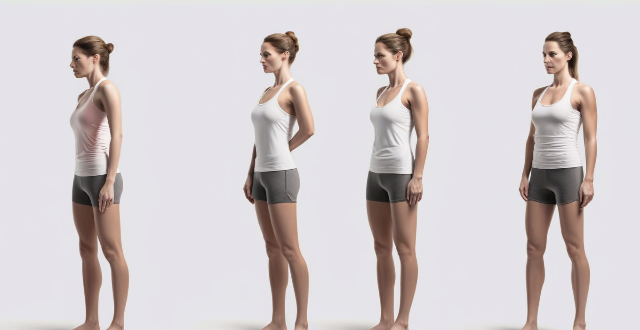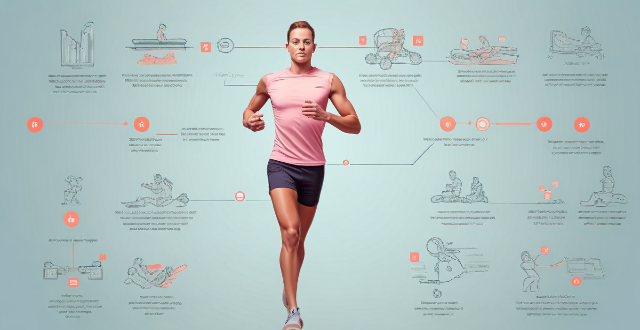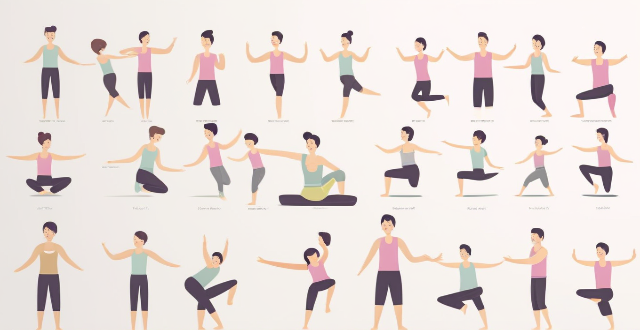Joint Exercise

How does understanding joint mechanics contribute to improving athletic performance through sports biomechanics ?
Understanding joint mechanics is crucial for improving athletic performance in sports biomechanics. By optimizing movement patterns, preventing injuries, enhancing force production, and improving stability, athletes can achieve greater success in their chosen sports. Sports biomechanists analyze an athlete's joint mechanics to develop targeted training programs that improve joint function and overall performance. Advances in sports technology provide real-time feedback on joint mechanics during training and competition, allowing athletes to fine-tune their technique and make adjustments to their training program as needed.

Can people with osteoporosis still do exercise safely ?
Osteoporosis is a condition characterized by low bone mass and deterioration of bone tissue, leading to brittle bones that are prone to fractures. It is a common concern among older adults, especially women. While exercise is generally recommended for maintaining overall health, it is important to consider the safety of physical activity for individuals with osteoporosis. In this article, we will explore whether people with osteoporosis can still do exercise safely and what precautions should be taken. Is Exercise Safe for People with Osteoporosis? Benefits of Exercise for Osteoporosis: - Improved Bone Density: Regular weight-bearing exercises can help improve bone density in individuals with osteoporosis. - Increased Strength and Balance: Resistance training and balance exercises can enhance muscle strength and reduce the risk of falls. - Better Quality of Life: Engaging in physical activities can improve mood, reduce pain, and enhance overall well-being. Risks Associated with Exercise for Osteoporosis: - Fracture Risk: High-impact activities or excessive force during exercise may increase the risk of fractures in people with osteoporosis. - Joint Stress: Some exercises may put excessive stress on joints, potentially leading to joint pain or damage. Safe Exercises for People with Osteoporosis: Weight-Bearing Exercises: - Walking: A low-impact activity that can help maintain bone density. - Dancing: A fun way to engage in weight-bearing exercise while also improving balance. Resistance Training: - Light Weight Lifting: Using light weights or resistance bands can strengthen muscles without putting too much strain on bones. - Bodyweight Exercises: Squats, lunges, and step-ups can be modified to suit individual abilities and provide resistance training benefits. Flexibility and Balance Exercises: - Tai Chi: A gentle form of exercise that focuses on slow, flowing movements to improve balance and flexibility. - Yoga: Certain yoga poses can help enhance flexibility, balance, and strength, but it is essential to avoid high-impact or bending poses that may increase fracture risk. Precautions to Take During Exercise: 1. Consult with a Healthcare Professional: Before starting any exercise program, it is crucial to consult with a healthcare professional who can assess your individual needs and risks. 2. Start Slowly: Begin with low-intensity exercises and gradually increase the duration and intensity as your body adapts. 3. Use Proper Technique: Ensure proper alignment and technique during exercises to minimize the risk of injury. 4. Wear Appropriate Footwear: Choose shoes with good support and cushioning to reduce the impact on joints and bones. 5. Avoid High-Impact Activities: Steer clear of activities like jumping or running that may increase the risk of fractures. 6. Listen to Your Body: If you experience pain or discomfort during exercise, stop immediately and seek advice from a healthcare professional. 7. Incorporate Rest Days: Allow your body time to recover between exercise sessions by including rest days in your routine.

Are there any age-related considerations when using exercise to prevent chronic diseases ?
Age-related considerations for using exercise to prevent chronic diseases include cardiovascular health, musculoskeletal health, balance and coordination, and cognitive health. Exercise intensity should be adjusted based on maximum heart rate, and low-impact exercises are recommended for joint pain. Weight-bearing exercises can help reduce the risk of osteoporosis. Balance and coordination exercises can reduce the risk of falls, and stretching can maintain flexibility. Regular exercise can also improve cognitive function and alleviate symptoms of depression and anxiety in older adults.

How does exercise physiology contribute to understanding the aging process and its effects on physical performance ?
Aging is a complex biological process that affects all living organisms, involving a gradual decline in physical and mental functions over time. Exercise physiology, the study of how the body responds to exercise, plays a crucial role in understanding the aging process and its effects on physical performance. As we age, our muscle mass and strength tend to decrease, cardiovascular fitness reduces, and joint pain and stiffness become more common. Exercise physiology helps us understand how the body adapts to regular physical activity at different stages of life, preventing age-related declines and promoting healthy aging through targeted exercise programs.

Is it better to do aerobic exercise in the morning or evening ?
The best time to do aerobic exercise depends on your personal preferences, schedule, and individual needs. Morning exercise can boost metabolism, improve mental clarity, and increase energy levels, but it may also be challenging to wake up early enough and could lead to lower performance and joint stiffness. Evening exercise can reduce stress, improve flexibility, and promote relaxation, but it may interfere with sleep, have time constraints, and cause fatigue. It's essential to listen to your body and choose a time that works best for you while maintaining consistency in your fitness routine.

What are the benefits of swimming for overall health and fitness ?
Swimming offers numerous benefits for overall health and fitness, including improved cardiovascular health, muscle strength and tone, joint mobility and flexibility, weight management, mental health, injury recovery and rehabilitation, and socialization. It is a low-impact, high-intensity workout that engages all major muscle groups in the body, making it an effective way to build strength and tone muscles without putting undue stress on the joints. Additionally, the buoyancy of water helps to reduce pressure on the joints, making swimming an ideal exercise for people with arthritis or other joint issues. Swimming also burns a significant number of calories, making it an effective way to manage weight. The rhythmic nature of swimming can be meditative, helping to clear the mind and promote relaxation. Overall, swimming is a great way to improve overall health and fitness.

Can exercise prevent osteoporosis ?
Exercise plays a crucial role in maintaining healthy bones by increasing bone density and strength. Effective exercises for preventing osteoporosis include weight-bearing exercises, strength training, balance exercises, high-impact exercises, and flexibility exercises. Incorporating these exercises into your routine can help reduce the risk of osteoporosis and maintain strong bones throughout your life.

How does exercise contribute to bone health ?
Exercise contributes to bone health by increasing bone density, improving balance and coordination, strengthening muscles, improving posture, reducing inflammation, and enhancing cardiovascular health. This reduces the risk of osteoporosis, fractures, back pain, and other health issues.

Why is it important to warm up before exercise ?
Warming up before exercise is crucial for preparing the body, preventing injuries, and improving performance. Benefits include increased blood flow, raised body temperature, loosened joints, prepared nervous system, reduced cardiovascular risk, and enhanced workout results.

How does exercise physiology explain the benefits of high-intensity interval training (HIIT) ?
High-intensity interval training (HIIT) is a form of exercise that involves short, intense bursts of activity followed by periods of rest or low-intensity exercise. From an exercise physiology perspective, HIIT offers numerous benefits, including increased metabolic rate, improved cardiovascular health, muscle development and endurance, favorable hormonal responses, mental health advantages, reduced injury risk, and time efficiency. These factors make HIIT a popular and effective method for achieving various fitness goals.

What are the benefits of a proper warm-up before physical activity ?
Warming up before physical activity is crucial for performance and injury prevention. Key benefits include increased blood flow, enhanced muscle temperature, joint lubrication, mental preparation, reduced injury risk, improved performance, and less muscle soreness. Incorporating a structured warm-up with dynamic stretching and specific exercises can maximize these benefits.

How does regular exercise contribute to occupational health ?
**Summary: Regular Exercise in Occupational Health** The article discusses the role of regular exercise in promoting occupational health, which encompasses physical, mental, and social well-being. It outlines the benefits of regular physical activity, including improved stamina, reduced injury risk, enhanced immune system, stress reduction, better cognitive function, increased resilience, team building, and a healthy work-life balance. The text emphasizes that incorporating exercise into daily routines can significantly enhance job performance and overall employee well-being. Employers are encouraged to implement wellness programs with exercise initiatives to foster a healthier and more productive workforce.

Can regular exercise help with insomnia ?
Insomnia, a sleep disorder making it hard to fall or stay asleep, affects many. Regular exercise is emerging as a natural remedy for insomnia. Exercise can positively impact sleep quality and duration by regulating the circadian rhythm and releasing endorphins. It also reduces stress and anxiety, leading causes of insomnia. Regular exercise boosts energy levels and mental health, further promoting better sleep. The recommended amount is 150 minutes of moderate-intensity activity weekly, including muscle-strengthening exercises. Tips for exercising with insomnia include choosing low-impact activities, avoiding high-intensity workouts at night, establishing a routine, being mindful of caffeine intake, and consulting a doctor before starting an exercise program.

How does exercise benefit the health of older adults ?
Exercise plays a crucial role in maintaining the health and well-being of older adults. Regular physical activity can significantly improve their quality of life by preventing diseases, promoting longevity, and enhancing mental health. This text discusses the various benefits of exercise for seniors, including improvements in strength, endurance, mobility, balance, chronic disease management, stress reduction, emotional health, cognitive functioning, social interaction, independence, and overall quality of life. Engaging in regular physical activity is one of the most effective ways for seniors to maintain a healthy and fulfilling lifestyle as they age.

Is it safe to exercise while taking immunosuppressant medications ?
Is it safe to exercise while taking immunosuppressant medications? This article explores the potential risks and benefits of exercising while taking immunosuppressant medications. While these drugs are essential for many people, they can also have side effects that may impact a person's ability to exercise safely. The primary concerns associated with exercising while taking immunosuppressant medications include an increased risk of infection, fatigue and weakness, and musculoskeletal issues. However, regular exercise has been shown to improve mental health, enhance immune function, and reduce the risk of chronic diseases. It is generally safe for individuals taking immunosuppressant medications to exercise, but they should take certain precautions to minimize their risk of infection and other potential complications.

How does exercise physiology help in preventing sports injuries ?
Exercise physiology helps prevent sports injuries by understanding body mechanics, energy systems, and recovery needs. Athletes can reduce injury risk through proper warm-up/cool-down, cross-training, progressive overload, and sufficient recovery time.

Does exercise have different effects on cognitive function at different ages ?
This article explores the relationship between exercise and cognitive function across various age groups. It highlights the benefits of exercise for children's cognitive development, adults' reduced risk of cognitive decline, and older adults' slowed cognitive decline. Examples of suitable exercises for each age group are provided, including playing sports for children, aerobic activities for adults, and walking or cycling for older adults. The article concludes that incorporating physical activity into daily routines at any age is crucial for maintaining cognitive health and overall well-being.

Are there any specific exercise programs designed for seniors that focus on building social connections ?
The article discusses the benefits of exercise programs for seniors that focus on building social connections. It highlights how regular exercise can improve physical health, mental health, and increase social connections in seniors. Examples of such programs include SilverSneakers, Tai Chi, walking groups, yoga, and water aerobics. The article emphasizes the importance of staying active and connected within communities as we age.

Is it safe to exercise during pregnancy and what precautions should be taken ?
Is it safe to exercise during pregnancy? Yes, as long as you follow certain precautions and guidelines, including consulting your healthcare provider, choosing appropriate exercises, listening to your body, staying hydrated, wearing comfortable clothing, using proper technique, avoiding lying flat on your back, not pushing yourself too hard, cooling down properly, and being mindful of environmental factors. Exercise can have numerous benefits for pregnant women, such as reducing the risk of gestational diabetes, improving mood, increasing energy levels, and helping with recovery after birth.

How do celebrities balance their busy schedules with regular exercise sessions ?
Celebrities balance their busy schedules with regular exercise sessions by prioritizing exercise, planning ahead, hiring personal trainers, incorporating exercise into daily routines, and making time for recovery. By following these tips, anyone can find ways to fit exercise into their busy lives and maintain good health and fitness.

Are there any risks associated with high-impact exercises for bone health ?
High-impact exercises, such as jumping and running, are recommended for bone health but come with risks like overuse injuries, acute injuries, joint problems, and cardiovascular risks. Mitigating these risks involves gradual progression, proper technique, adequate rest, appropriate gear, and medical consultation.

What are the best types of exercises for stress relief ?
The best types of exercises for stress relief include aerobic exercise, yoga, pilates, tai chi, and strength training. Aerobic exercise increases your heart rate and makes you sweat, which can help to reduce stress levels. Yoga helps to calm the mind and body, reducing stress and anxiety levels. Pilates focuses on strengthening the core muscles, improving posture and balance, and increasing flexibility. Tai Chi combines deep breathing with slow, flowing movements and has been shown to be effective in reducing stress levels. Finally, strength training involves using resistance bands or weights to build muscle strength and endurance.

Are there any special considerations when designing a workout plan for women ?
When designing a workout plan for women, special considerationWhen designing a workout plan for women, special consideration account, including hormon Women also tend to have a higher percentage of body fat compared to men, which can impact their exercise needs. If a woman is pregnant or has recently given birth, her workout plan should be adjusted accordingly. Women are at a higher risk for osteoporosis than men, so it is important to incorporate exercises that promote bone health into their workout plan. Finally, women are more likely to experience joint pain and injuries due to factors such as wider hips and smaller knees, so it is important to choose exercises that are low-impact and put less stress on the joints. By taking into account these factors, you can create a safe and effective workout plan that helps women achieve their fitness goals while minimizing the risk of injury or other complications.

Can exercise alleviate symptoms of PTSD ?
Exercise has been shown to alleviate PTSD symptoms such as flashbacks, nightmares, and avoidance behaviors. Research suggests that exercise may reduce anxiety and depression, improve mood, reduce stress, and improve sleep quality in individuals with PTSD. Endorphins released during exercise may also play a role in reducing symptoms. However, more research is needed to determine the optimal types and doses of exercise for different populations.

Can exercise reverse heart disease ?
Heart disease is a major cause of death worldwide, and it can be devastating to those affected. While there are many treatments available for heart disease, including medication and surgery, some people wonder if exercise can reverse the damage caused by heart disease. There is evidence that regular exercise can help prevent and manage heart disease by improving cardiovascular health, managing weight, lowering blood pressure, improving cholesterol levels, and reducing stress. However, there is no conclusive evidence that exercise can completely reverse heart disease. Despite this, there are still many benefits to regular exercise for heart health. If you have been diagnosed with heart disease or are at high risk for developing it, talk to your doctor about starting an exercise program. They can help you create an exercise plan that is safe and effective for your individual needs and goals.